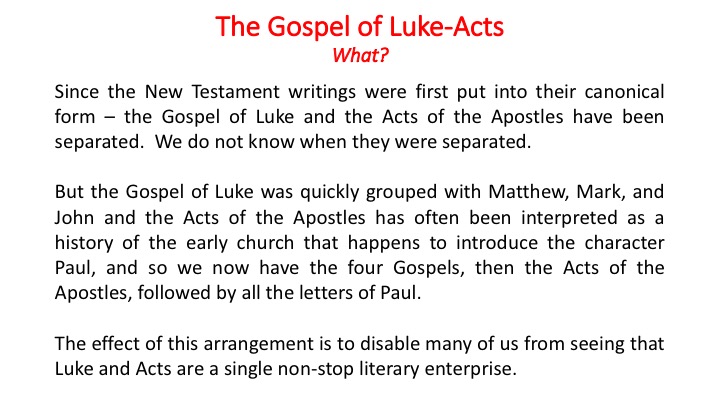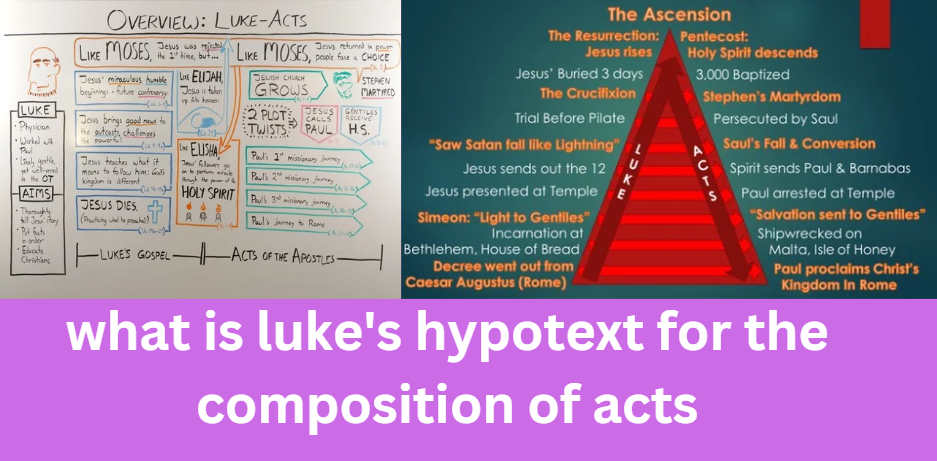The composition of the Acts of the Apostles has intrigued scholars for centuries. One key area of study is the relationship between the Gospel of Luke and Acts, often referred to as “Luke-Acts.” Scholars have explored how Luke may have used a “hypotext,” or pre-existing source, to craft Acts, ensuring a seamless theological narrative between the two books. This article dives into the question, “What is Luke’s hypotext for the composition of Acts?” to examine possible sources, analyze scholarly interpretations, and provide insights that go beyond existing discussions.
Contents
- 1 1. Understanding the Concept of Hypotext in Biblical Literature
- 2 2. The Relationship Between Luke’s Gospel and Acts
- 3 3. Possible Hypotexts for the Composition of Acts
- 4 4. Luke’s Theological Coherence Between the Gospel and Acts
- 5 5. Analysis: Luke’s Creative Use of Hypotexts
- 6 6. Scholarly Perspectives on Luke’s Hypotexts
- 7 7. FAQs About “What is Luke’s Hypotext for the Composition of Acts”
- 7.1 Q1: Did Luke write Acts based only on the Old Testament?
- 7.2 Q2: How does the concept of hypotext help in understanding Acts?
- 7.3 Q3: What makes Luke-Acts unique in the New Testament?
- 7.4 Q4: Are there any non-biblical hypotexts in Acts?
- 7.5 Q5: How do scholars determine what Luke’s hypotexts might have been?
- 8 Conclusion
- 9 Related Posts Like What is Luke’s Hypotext for the Composition of Acts
1. Understanding the Concept of Hypotext in Biblical Literature

Before diving into Luke’s hypotext for Acts, it’s essential to understand what a hypotext is. In literary studies, a hypotext is an earlier text that serves as the basis or inspiration for a new work, known as the hypertext. The hypertext builds upon, adapts, or transforms the hypotext, creating a new narrative while retaining connections to the original.
In biblical studies, this concept helps scholars identify potential sources that authors like Luke may have drawn upon. For the Gospel of Luke and Acts, the idea of a hypotext allows for a deeper exploration of how these texts were composed, crafted, and interconnected.
2. The Relationship Between Luke’s Gospel and Acts
Luke’s Gospel and Acts are often viewed as two volumes of a single work. Written by the same author, they share a common literary style, thematic elements, and theological outlook. This continuity has led scholars to ask, “What is Luke’s hypotext for the composition of Acts?” to understand how these two books are so intricately linked. It is believed that Luke may have used earlier sources, oral traditions, and written texts to create a cohesive narrative that spans the life of Jesus and the early Christian movement.
3. Possible Hypotexts for the Composition of Acts

3.1 The Hebrew Bible (Old Testament)
One of the most widely acknowledged hypotexts for Acts is the Hebrew Bible, also known as the Old Testament. Luke’s writing in both his Gospel and Acts frequently alludes to the Hebrew Scriptures. By using Old Testament motifs, prophecies, and figures, Luke not only situates the story of Jesus and the early church within the broader history of Israel but also underscores the continuity of God’s plan from the Old Testament to the New Testament.
Examples:
- Pentecost and the Prophecy of Joel (Acts 2:16-21): Luke’s account of the Holy Spirit descending upon the apostles during Pentecost is framed as the fulfillment of Joel’s prophecy.
- Jesus as the New Moses: Luke portrays Jesus as a new leader who guides his followers, akin to Moses leading the Israelites. This theme extends into Acts, where the apostles continue this mission.
3.2 Greco-Roman Historiography
Another significant hypotext for Acts could be Greco-Roman historiographical traditions. Luke’s style in Acts resembles that of ancient historians like Thucydides and Herodotus. These historians wrote narratives that chronicled events with a mix of factual reporting, rhetorical flourishes, and literary creativity. Luke may have been inspired by this style to craft a compelling narrative that would appeal to both Jewish and Gentile audiences.
Examples:
- The Speeches in Acts: The speeches recorded in Acts (e.g., Peter’s speech in Acts 2, Stephen’s speech in Acts 7, and Paul’s defense in Acts 26) reflect Greco-Roman oratorical styles, suggesting that Luke drew on contemporary historiographical practices.
3.3 The Septuagint (LXX)
The Septuagint, the Greek translation of the Hebrew Bible, is another potential hypotext. Luke frequently cites or alludes to the Septuagint in his Gospel and Acts. His use of Greek language and specific scriptural references indicates that the Septuagint was a foundational text for Luke’s theological framework.
Examples:
- Acts 15 and the Council of Jerusalem: Luke’s account of the council borrows language from the Septuagint, using it to frame debates about the inclusion of Gentiles within the Christian community.
- Typological Connections: By employing language from the Septuagint, Luke draws typological parallels between Old Testament events and the early church, emphasizing themes of continuity and fulfillment.
3.4 Early Christian Oral Traditions
In addition to written hypotexts, Luke likely relied on oral traditions about Jesus’ life, teachings, and the early church. Oral narratives were a common means of preserving and transmitting stories in the ancient world. These traditions may have been crucial for Luke as he composed Acts, particularly for events that had not been recorded in earlier written texts.
Examples:
- Miraculous Events and Healings: Stories of healings, exorcisms, and other miracles in Acts could have been transmitted through oral traditions that Luke incorporated into his narrative.
- Eyewitness Accounts: Acts 1:1-2 suggests that Luke had access to firsthand accounts, possibly from figures like Peter, Paul, and other early Christians.
4. Luke’s Theological Coherence Between the Gospel and Acts
4.1 Narrative Unity
One of the reasons Luke may have used a hypotext was to ensure narrative coherence. By establishing clear theological and narrative connections, Luke provided a seamless transition from the Gospel to Acts. This continuity allows readers to see the events of Acts as a direct continuation of the Gospel narrative, with the apostles carrying forward Jesus’ mission.
4.2 Themes of Salvation History
A key theme in both the Gospel of Luke and Acts is “salvation history”—the belief that God’s plan of salvation unfolds throughout human history. Luke uses various hypotexts to highlight how the events of Jesus’ life, death, resurrection, and the spread of the early church fulfill God’s promises from the Old Testament.
Examples:
- The Role of the Holy Spirit: The Holy Spirit is a central figure in both books, guiding Jesus’ ministry in the Gospel and empowering the apostles in Acts.
- Mission to the Gentiles: Acts demonstrates how the message of Jesus extends beyond the Jewish community, fulfilling Old Testament prophecies about the inclusion of all nations.
5. Analysis: Luke’s Creative Use of Hypotexts

5.1 Intertextuality in Luke-Acts
Luke’s use of hypotexts reflects a sophisticated form of intertextuality, where he blends elements from Jewish Scriptures, Greco-Roman literature, and early Christian teachings to craft a new narrative. This creative process allows Luke to assert theological truths while situating the Christian story within the broader context of known historical and cultural traditions.
5.2 Literary Techniques
Luke employs several literary techniques, such as typology, foreshadowing, and thematic repetition, to create a cohesive and theologically rich narrative. These techniques suggest that Luke was not merely copying earlier texts but was actively engaging with them to present a unique perspective on the life of Jesus and the early church.
5.3 Beyond Historical Sources: Theological Intent
While historical sources are crucial, Luke’s ultimate intent was theological. By carefully selecting and adapting his hypotexts, Luke presents a theological vision that portrays Jesus as the fulfillment of God’s promises and the early church as the continuation of Jesus’ mission. This theological coherence is a hallmark of Luke’s writing style, making his works distinct among New Testament texts.
6. Scholarly Perspectives on Luke’s Hypotexts
6.1 Consensus Views
Most scholars agree that Luke had access to multiple sources, including the Hebrew Bible, the Septuagint, and early Christian traditions. His use of these texts reveals a deep understanding of Jewish Scriptures and a desire to present Jesus as the fulfillment of Old Testament prophecy.
6.2 Diverging Opinions
There is, however, debate about the extent to which Luke was influenced by Greco-Roman literature. Some scholars argue that Luke’s narrative style and structure bear significant similarities to ancient historiographical works, while others caution against overemphasizing these parallels.
6.3 Recent Research Trends
Recent studies have begun to focus on how Luke’s use of hypotexts reflects broader social, political, and cultural trends of his time. This approach helps to contextualize Luke-Acts within the Greco-Roman world, offering new insights into its message and purpose.
7. FAQs About “What is Luke’s Hypotext for the Composition of Acts”
Q1: Did Luke write Acts based only on the Old Testament?
A: While the Old Testament was a major source, Luke also drew upon Greco-Roman literary styles, oral traditions, and early Christian teachings to compose Acts.
Q2: How does the concept of hypotext help in understanding Acts?
A: The concept of hypotext allows scholars to identify the sources Luke used, shedding light on his theological intentions and the narrative structure of Luke-Acts.
Q3: What makes Luke-Acts unique in the New Testament?
A: Luke-Acts is unique because it presents a continuous narrative from the life of Jesus to the early church, emphasizing themes of salvation, inclusion, and the work of the Holy Spirit.
Q4: Are there any non-biblical hypotexts in Acts?
A: Yes, Luke may have been influenced by Greco-Roman historiography, which shaped his narrative style, particularly in the presentation of speeches and events.
Q5: How do scholars determine what Luke’s hypotexts might have been?
A: Scholars analyze linguistic parallels, thematic connections, and narrative structures to identify potential hypotexts that Luke may have used when composing Acts.
Conclusion
Understanding “what is Luke’s hypotext for the composition of Acts” provides a fascinating glimpse into the world of early Christian literature. By identifying and analyzing Luke’s possible sources, we can appreciate the complexity and depth of his theological vision. Luke-Acts remains a remarkable narrative that bridges the story of Jesus and the mission of the early church, rooted in ancient traditions yet forward-looking in its message.





















+ There are no comments
Add yours